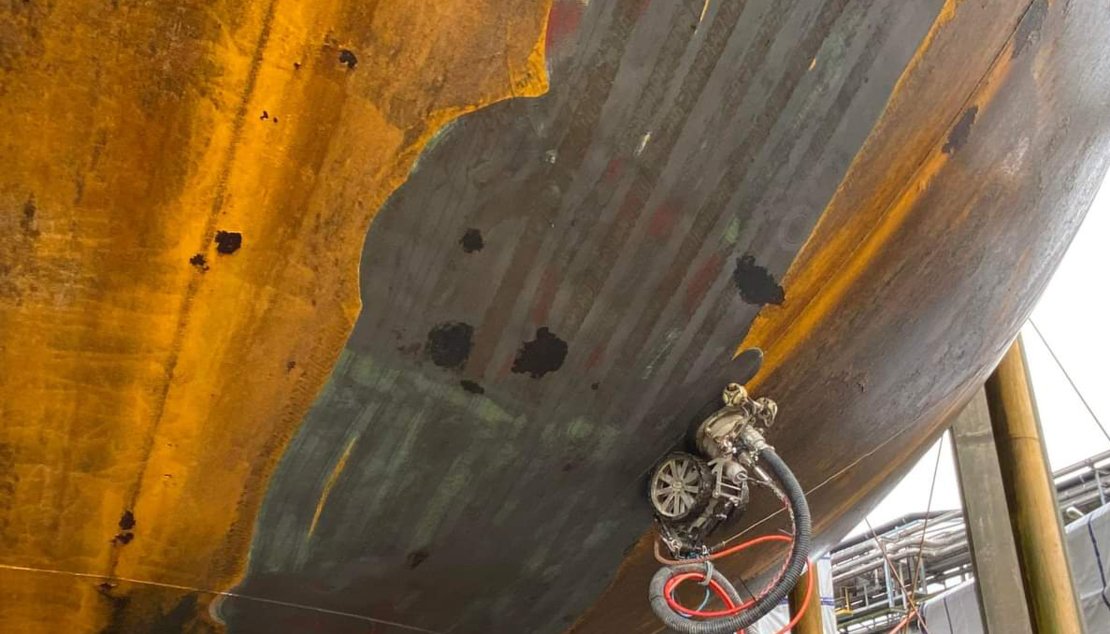ROBOTIC SURFACE TREATMENT OF AMMONIA TANKS AT HERØYA
December 2, 2022
administrator
Complex maintenance can now be carried out by robotic solutions from the oil and gas industry.
Surface treatment of industrial tanks has traditionally meant extensive manual work during both preparation and implementation. Now, with new robotic solutions from the oil and gas industry, such maintenance can be done more efficiently and sustainable, while reducing challenging and burdensome work for personnel.
– Today, only parts of the surface treatment are done with the help of robots, but this will increase along with the technological development. Future maintenance will be both more efficient and sustainable, says CEO Arild Apelthun in Beerenberg. The transition will be done with help from the expertise of our professional personnel.
Complex maintenance work
Maintenance of large industrial tanks is a comprehensive process that includes scaffolding, sandblasting and painting of each tank, in addition to ensuring good HSE for working personnel. Many tanks at Norwegian industrial plants are also covered with lead-containing paint, which is subject to particularly strict HSE and environmental requirements. For Yara, which has tested the new surface treatment at its facility on Herøya, it was important that all these factors were well taken care of in the process.
– We have two large ammonia tanks (buffer tanks) that have long been in dire need of refurbishment, and we wanted to get the work done this fall. A paint sample revealed lead chromate content, which entails a particularly strict regimen of blood tests and close follow-up of our skilled workers both before and after sandblasting. Beerenberg’s solution considered HSE as well as effectively solving the task using robots, says project manager Tom Caspersen.
At Yara’s ammonia tank, the robot does 70 percent of the work, which reduces the burden on employees considerably. Where the UHT robot cannot reach, traditional sandblasting is used. Looking at the lead paint specifically, 90 percent of lead paint is removed with the help of a robot. Only the remaining 10 percent, around the structures of the tank, had to be done manually. Each tank is 750 m2.
– We were surprised how efficient the robot was. It saves us a lot of work when it comes to sandblasting. Since we must wash the tanks anyway, it is beneficial to use water jetting and vacuum collection. Robotic pretreatment saves our personnel from exposure to lead chromate and lead-containing paint, enables a 70 percent reduction in sand consumption. It is also an advantage not to have to build a scaffolding tent, because the robot can do the job without it, says Caspersen.
Kristian Henriksen in Beerenberg, sees a great potential in using robotic solutions at industrial land plants and surfaces treated with lead-containing paint.
Sustainable maintenance
Lead-containing paint is still found on many tanks at Norwegian industrial plants. Maintenance of these is subject to particularly strict requirements for HSE and the environment, and here the new technologies can be of great help.
Strict environmental regulations are important for stable and safe operations at the Herøya Yara plant. Today, the robotic maintenance solutions collect 100 percent of the waste, which is then filtered to reduce paint waste and further disposal.
– Future solutions are both efficient and environmentally friendly, as well as saving employees from noise and vibrations, says Kristian Henriksen. We therefore recommend the use of more sustainable maintenance solutions like this. What is good for the environment is often also good for business, he adds.
In terms of quality, it is also smoother when using water jetting (UHT) versus traditional pre-treatment. When planning such assignments early, it is possible to simplify the process by using rope access or a lift in areas not covered by the robot, and spray painting manually, rather than setting up scaffolding.
– We have a good cooperation in the project, with a project organization that can deliver. We are now looking forward to see the result when both tanks are fully refurbished by Christmas, says Caspersen.
In addition to the robotic maintenance work, Beerenberg has a framework agreement for scaffolding work for Yara’s plant at Herøya. The factory area is Norway’s largest industrial area with its 1.5 square kilometers.
Related Posts
YOUR GATEWAY TO THE NORWEGIAN EXPORT MARKET
Search Norway’s largest database of exporters:
• 35 business sectors
• 2000 product groups
• 8000 products & services
• Companies, trademarks, products or services

